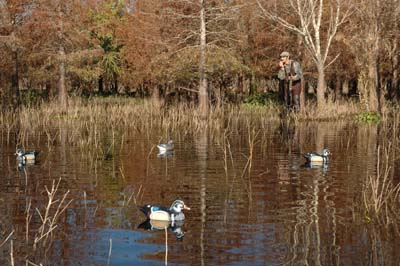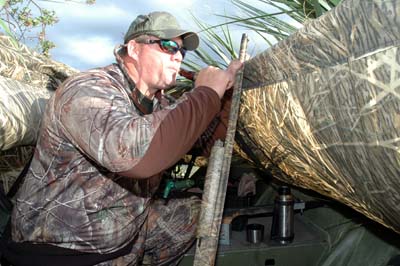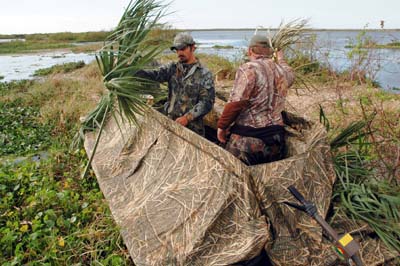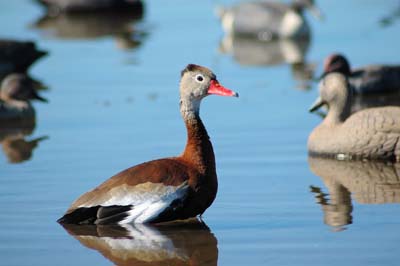St. John's River creates abundant waterfowl habitat
Story and photos by John N. Felsher
Many people call central Florida “America’s Playground” for good reason, particularly as an escape from brutal northern winters. Besides the beaches, Disney World, and a host of other theme parks, sportsmen can find a different kind of winter recreation within a reasonable drive from Orlando.
“I’ve hunted ducks in eastern Florida for more than three decades,” commented Dan Daniels, a dedicated waterfowler with United Waterfowlers-Florida (unitedwaterfowlersfl.org). “Eastern Florida has many public places where people can hunt. Sportsmen can pretty much hunt ducks wherever they like in the main river channels and the natural lakes associated with the St. John's River.”
The St. John's River rises from springs west of Vero Beach and flows slowly northward for 310 miles before entering the Atlantic Ocean near Jacksonville. The watershed covers more than 1,888 square miles. The upper basin spreads across an immense wild swath of natural lakes, swamps, marshes, and labyrinthine backwaters in the rich wetlands of eastern Florida.
 These wetlands create abundant waterfowl habitat. In general, since navigable waterways belong to the public, sportsmen can hunt waterfowl on thousands of acres of lakes and natural channels. However, for safety and conservation reasons, some areas specifically prohibit hunting or discharging firearms. In addition, waterfowlers can also hunt several wildlife management areas, but some public properties require special permits, operate under a quota system, or only allow hunting for limited hours on specific days. Always check the regulations before hunting anywhere.
These wetlands create abundant waterfowl habitat. In general, since navigable waterways belong to the public, sportsmen can hunt waterfowl on thousands of acres of lakes and natural channels. However, for safety and conservation reasons, some areas specifically prohibit hunting or discharging firearms. In addition, waterfowlers can also hunt several wildlife management areas, but some public properties require special permits, operate under a quota system, or only allow hunting for limited hours on specific days. Always check the regulations before hunting anywhere.
“The Upper St. John's River is one of the Atlantic Coast Joint Ventures focal waterfowl areas due to its vast amount of waterfowl habitat,” advised Mark McBride, a Florida Fish and Wildlife Conservation Commission biologist based at T.M. Goodwin Public Small Game Hunting Area in Fellsmere. “Almost the entire St. John's River is hunt-able. There are some posted areas, but otherwise, almost everything within the mean high-water line is public water.”
 Approximately 20 waterfowl species, including some rarely seen in most other states, regularly winter in Florida. Ring-necked ducks, blue-winged teal, and mottled ducks generally rank among the common waterfowl in the peninsula. In the marshes, sportsmen might also kill green-winged teal, pintails, shovelers, wigeon, gadwalls, diving ducks, and a few mallards. In wooded areas, sportsmen might also bag wood ducks and hooded mergansers.
Approximately 20 waterfowl species, including some rarely seen in most other states, regularly winter in Florida. Ring-necked ducks, blue-winged teal, and mottled ducks generally rank among the common waterfowl in the peninsula. In the marshes, sportsmen might also kill green-winged teal, pintails, shovelers, wigeon, gadwalls, diving ducks, and a few mallards. In wooded areas, sportsmen might also bag wood ducks and hooded mergansers.
“Blue-winged teal and mottled ducks are the two most harvested ducks on the river,” McBride detailed. “T. M. Goodwin and Merritt Island National Wildlife Refuge are areas most likely to hold pintails and wigeon, although these birds are occasionally found on the St. John's floodplain, too. The upper basin of the St. John's system has many impoundments, including Goodwin, that winter lots of ducks. Impoundments that have a lot of hydrilla usually attract a good number of ring-necked ducks.”
One of the premier public waterfowling areas in Florida, the T. M. Goodwin and associated Broadmoor Marsh Unit, include 6,482 acres of moist soil units and restored wetlands in Brevard County. Intensively managed to provide quality waterfowl habitat throughout the winter, these properties allow limited hunting on certain days.
The Upper St. John's River Marsh WMA traditionally offers some of the best public waterfowl habitat in the state. It sprawls over 120,386 acres of the river basin west of Melbourne. Many people hunt small pockets off Lakes Winder, Poinsett, or Washington. The Puzzle Lake and Moccasin Island areas usually hold some ducks.
“The St. John's River can be hit or miss due to water levels, but when conditions are right, hunting can be good,” McBride explained. “The Upper St. John's River Marsh WMA encompasses most of the impoundments and the main river channel where hunters can find birds and have unlimited access. The most popular stretch for waterfowl hunting on the river is between State Routes 46 and 520 east of Orlando.”
One of the newest public hunting areas, the Charles H. Bronson WMA covers 11,672-acres within the Bronson State Forest along the St. Johns River in Seminole and Orange counties south of Lake Harney. Not far away, people can also hunt the Little Big Econ WMA on the Econlockhatchee River, a tributary to the St. Johns near Geneva. Not far away, people can also hunt the Buck Lake WMA in Brevard and Volusia counties and Salt Lake WMA in Brevard County.
With so much public land available, do-it-yourself sportsmen can usually find a good place to throw decoys, but they may need to locate the birds first. Many river waterfowlers scout and hunt from boats that come equipped with pop-up blinds. With such a rig, hunters can pick a pond, toss out a few decoys, raise the blind and begin hunting in minutes. If nothing happens there, sportsmen can easily pick up the decoys, move to another location, and resume hunting. Frequently, waterfowlers hunt several spots in one day to keep up with the birds.
“Scouting is critical,” Daniels counseled. “I usually look more for spots with good habitat rather than actual birds. I’ve hunted some spots that I’ve never seen a bird, but on opening day, it’s covered with ducks. Usually, we hunt out of a boat with a pop-up blind, but sometimes we just hide in the grass. We might leave the boat in one spot and walk to an inaccessible pond to hunt.”
Without a fancy pre-rigged blind, some sportsmen simply run a small boat into tall reeds or cover it with native vegetation. Bend cattail stalks or canes over the boat or pile cut brush and branches on the deck to break up the outline. Some hunters park their boats and walk some distance away to crouch in available native vegetation to shoot puddle ducks.
 The St. John's River runs through several large lakes that can also provide good hunting including Lakes Dexter, Woodruff, Jesup, and Harney. Larger lakes naturally attract more divers, such as ring-necked ducks, scaup, some redheads, canvasbacks, ruddy ducks, and common mergansers. Along the wooded shorelines or in the grassy flats, sportsmen would more likely bag hooded mergansers, wood ducks, teal, and other puddle ducks.
The St. John's River runs through several large lakes that can also provide good hunting including Lakes Dexter, Woodruff, Jesup, and Harney. Larger lakes naturally attract more divers, such as ring-necked ducks, scaup, some redheads, canvasbacks, ruddy ducks, and common mergansers. Along the wooded shorelines or in the grassy flats, sportsmen would more likely bag hooded mergansers, wood ducks, teal, and other puddle ducks.
To the north, Lake George covers 46,000 acres near Deland. Nearly surrounded by public hunting lands, the second largest freshwater lake in Florida sits adjacent to the 383,000 acre Ocala National Forest. Across the lake, Lake George WMA covers 39,642 acres. Many people hunt the open waters of the lake in boat blinds, but waterfowlers without boats can wade across the mostly hard, sandy bottom and hunt thick vegetated patches along the shorelines.
“Larger lakes within the river system, such as Lake George, can hold lots of ducks if submersed vegetation is plentiful,” McBride explained. “The managed marshes like Goodwin and Merritt Island NWR are popular and provide the most consistent action, but hunt days are limited and hunters might need a special permit. Merritt Island NWR is an iconic waterfowl area on the East Coast. It typically winters lots of pintails and wigeon. The Indian River Lagoon is a great place to hunt diving ducks. People mostly bag lesser scaup, also called bluebills, but they might also get canvasbacks, redheads, an occasional sea duck, and other birds mixed in.”
Technically not part of the St. John's system, Merritt Island NWR covers 140,000 acres of salt marshes, estuaries, and freshwater impoundments along the Atlantic Ocean near Titusville. Established in 1963 as a buffer zone for the John F. Kennedy Space Center, the refuge typically holds a good variety of ducks in the winter.
“Merritt Island NWR has a long history of waterfowl hunting, even before NASA or the refuge were established,” commented Stan Howarter, a wildlife biologist for the refuge. “After NASA purchased the land, one of the commitments was to make land available to waterfowl hunters. The land is owned by NASA but managed for wildlife by the U.S. Fish and Wildlife Service.”
People can hunt waterfowl on about 36,000 acres of the refuge on designated days by permit. Some units limit hunting pressure with a quota system. People can also hunt parts of the Indian River and Mosquito lagoons, but the Banana River remains closed to all hunting.
“The most popular hunting areas are Peacocks Pocket, Shiloh 5 and L Pond, but these are for quota hunts,” Howarter recommended. “The quota system allows for better quality hunts in those areas. Biolab is probably the most popular area without a quota permit. It’s a big area with quality habitat. People can spread out in the area. People shoot a lot of blue-winged teal on the refuge. The second most common duck is lesser scaup. Historically, this area has also been a great place for wigeon and pintail. People also kill a few mallards. A fair number of mottled ducks live on the refuge. Occasionally, someone gets a true black duck.”
Even as far away as Orlando, people in eastern Florida can experience what few other waterfowlers ever see -- a space launch! At times, NASA prohibits access to parts of the refuge because of a launch. For more information about hunting Merritt Island NWR, see www.fws.gov/refuge/Merritt_Island/visit/rules_and_regulations.html.
Also near, but not part of the St. John's River watershed, the Kissimmee Chain of Lakes can provide good gunning opportunities for waterfowl. Linked by the Kissimmee River, the chain of lakes spreads across more than 100,000 acres south of Orlando. The Kissimmee River eventually flows into Lake Okeechobee, another excellent waterfowling spot.
The 22,700 acre Lake Tohopekaliga, locally called Lake Toho, anchors the northern section of the chain while the 44,000-acre Lake Kissimmee caps off the southern part east of Lake Wales. People can hunt the main lakes and other navigable waters or some WMA's in the area. The area usually produces good numbers of divers and teal with some gadwalls, wigeons, pintails and mallards.
Throughout the Florida Peninsula, visiting sportsmen might add a few species to their “bucket lists” of birds they would like to shoot, such as mottled ducks. People might also kill hooded mergansers, whistling ducks and perhaps an occasional sea duck.
 “Many waterfowlers like to visit different areas of the country to possibly shoot species they might never see around their home states,” Daniel remarked. “It’s common for waterfowlers to travel to Florida and scratch one or two bucket list species off their lists. In the salt marshes, people kill a lot of mottled ducks. On larger water bodies, people might kill a sea duck, like a scoter, which is another relatively new species for this area. In the past decade, we’ve seen a lot more resident black-bellied whistling ducks, which most people in the United States never see.”
“Many waterfowlers like to visit different areas of the country to possibly shoot species they might never see around their home states,” Daniel remarked. “It’s common for waterfowlers to travel to Florida and scratch one or two bucket list species off their lists. In the salt marshes, people kill a lot of mottled ducks. On larger water bodies, people might kill a sea duck, like a scoter, which is another relatively new species for this area. In the past decade, we’ve seen a lot more resident black-bellied whistling ducks, which most people in the United States never see.”
Once called “Florida ducks,” mottled ducks love salty marshes. The non-migratory birds resemble hen mallards and rarely stray far from the Gulf of Mexico or southern Atlantic Ocean coastlines. Since mottled ducks live in their marshes all year long, they rarely come to decoys and can easily spot blinds. The wary birds habitually fly past blinds just beyond shotgun range, but sportsmen sometimes kill a passing duck that ventures too close.
Some people paddle the sloughs and winding channels in canoes or kayaks to jump mottled ducks. With a small, quiet paddle craft, sportsmen can sneak up on isolated potholes where the birds like to hide. Without a small boat, most other hunters could never reach these potholes.
“Outside of south Florida, east-central Florida is probably the second-best place to bag a mottled duck,” McBride advised. “The shallow St. John's floodplain is home to a large population of mottled ducks. Black-bellied whistling ducks are becoming more common throughout this area as well.”
Formerly called “tree ducks,” black-bellied and fulvous whistling ducks look like no other North American waterfowl. With long legs and necks, whistling ducks somewhat resemble geese and frequently walk on land or perch in branches. Whistling ducks typically breed along the lower Texas coast and southwestern Louisiana. Most migrate to Mexico or parts farther south to spend the winter. By the time duck hunting season begins in most states, whistlers disappear. In recent years, however, they spread northward and eastward. A resident population now lives in Florida all year long. The highly gregarious birds can become quite numerous in local areas and frequently gather in huge flocks.
Before You Go
When visiting the Sunshine State to hunt ducks, bring raingear and traditional warm, dry waterfowling clothing, but sportsmen might not need the heavy stuff even late in the season. Sometimes, though, a freezing cold front combined with the humidity and the chill wind coming off the Atlantic Ocean can make an unprepared waterfowler miserable on a harsh winter day.
“In Florida, don’t become preoccupied with cold weather,” Daniels quipped. “Birds come down here whether it’s cold or not. It’s not unusual to hunt in short sleeves even late in the season. Cold weather helps, but it’s not absolutely necessary to successfully hunt ducks in the Sunshine State. In can get very cold at times, but people might not need their heavy coats. People will probably need their raingear. We can get some nasty thunderstorms during duck season.”
When weather conditions stay warm, the bugs come out. Marsh mosquitoes can become quite vicious, so bring enough insect repellent. Warmer weather may also bring out larger pests. Even in late season, waterfowlers might spot many big alligators. The prehistoric reptiles commonly lurk around the blinds waiting for a free duck meal to fall out of the sky, but they seldom bother humans. However, they love grabbing a dog for a quick meal. A giant gator can quickly take down an adult Labrador retriever with little trouble, so many Florida waterfowlers leave their dogs at home.
Anyone who wishes to hunt waterfowl or other migratory birds in Florida must purchase the appropriate state hunting licenses and a migratory bird permit. Sportsmen wishing to hunt waterfowl also need to buy a Florida waterfowl permit and a federal migratory bird stamp. In addition, some public areas only allow quota hunting by permit. For license information, see www.myfwc.com/license/recreational/hunting.
For maps, season dates and additional information about specific wildlife management areas, see www.myfwc.com/hunting/wma-brochures. Another good source of information, the Guide to Waterfowl Hunting in Florida lists popular duck hunting spots, publishes waterfowl identification photos, and hunting regulations.
 While in the Area
While in the Area
After hunting ducks in the morning, sportsmen might want to try their hand at hitting snipe in season. Walk the marshes and shoot at the little speedsters as they flush. In addition, most hunting properties that offer good waterfowl hunting also hold large numbers of wild hogs that could make an excellent bonus to any Florida adventure.
Sportsmen might also want to experience a “blast and cast,” shooting ducks in the morning and fishing in the afternoon. The entire St. John's River system offers some of the best largemouth bass fishing in the nation.
Throughout the system, anglers frequently catch double-digit bass. Some of the biggest fish hit in late winter during the waterfowl season.
Freshwater anglers might also make good catches of sunfish, crappie, and catfish, plus other species. For something different, head south around Miami to tempt hard-fighting South American peacock bass and many other exotic species available nowhere else in the United States. Of course, from any place in Florida, sportsmen can find pristine beaches and saltwater action after just a short drive to the coast.
People tired of spending money at tourist attractions might visit the oldest continuously inhabited European-established city in the continental United States. The Spanish founded St. Augustine on the northeast Florida coast in 1565. Once guarding the town, the Castillo de San Marcos, the oldest and largest masonry fort in the continental United States, dates to 1672.
With so many lakes and waterways coursing through this area, people not familiar with the terrain could become easily lost, especially in the darkness. Many channels look identical. Moreover, what may look like a wide main channel on a GPS system, in person might leave a boat stranded on a mudflat. Sportsmen need to be careful when running the St. John's system.
Whether someone wants to bag a bucket list bird not found near home, see a rocket launch, or just enjoy some good shooting in beautiful scenery, eastern Florida can offer the do-it-yourself waterfowlers an enjoyable experience over a vast territory with abundant public hunting opportunities. Waterfowlers just need to find where the birds want to go.

